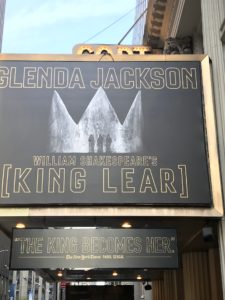Spending an afternoon with my eco-theory grad students at Dead Horse Bay was the ideal way to pregame the ambitious, wayward, and sometimes overwhelming production of King Lear that’s currently at the Cort Theatre on 48th St. Dead Horse Bay’s particular flavor of #trashpastoral shows off fragments of ruined nature, the leeched detritus of more than a century’s urban waste. But it’s also — as I’ve shared with students before in relation to King Lear — a place of strange posthuman beauty.

On Tuesday afternoon the tide was high enough to keep us pinned to the upper half of the beach, where we poked around amid the collection of nineteenth-century glass and leather as well as plastic of more recent vintage. A breeze from off the Rockaways kept the air fresh, and a fisherman’s arrival showed how even old landfills remain part of living ecologies. King Lear gives us Shakespeare’s greatest vision of apocalypse and inhospitable nature, which is the reason I’ve long been convinced that this play is essential art for the Anthropocene. Dead Horse Bay hits us with the same alien pressure, and reminds us that living persists amid decay. I love this ugly place, and it provided the best answer ever to Julio Cortazar’s perfectly-phrased question about the role of iconic literary art in modern lives:

If I get so carried away by a spider-web covered with dew, what will I do in the evening when we are going to see King Lear?
(Around the Day in Eighty Worlds)
Sam Gold’s inventive staging of Lear mostly eschewed local references, though the Fool did show off American flag socks when chanting Merlin’s prophecy of misrule after the storm. The glittery-golden set located almost all the action indoors, with the storm and hovel scenes of act 3 somewhat oddly placed on the liminal space in front of the lowered curtain. (It worked for me, since I was in the front row and about five feet from the mad king raging at thunder — but I wondered about confining this outward-facing moment.) Many of Gold’s more radical stage gambits did not hit their marks, and not all the performances were strong — but at the center of the production a trio of brilliant actors shouldered the play’s massive weight.

I was especially looking forward to John Douglas Thompson’s Kent, having seen his stunning star turns as Tamburlaine and as Louis Armstrong in “Satchmo at the Waldorf.” Kent is the play’s conscience, and Thompson’s easy charisma and perfect clarity were a good fit for the role. He was especially winning when disguised as Caius, wooing and serving the increasingly mad old king. I wasn’t absolutely sure I bought his final despair — he seemed more like someone who would pick the kingdom up and put it back together — but it was a great performance by one of our greatest actors. I look forward to him in the title role!
The surprise break-out for me was Elizabeth Marvel as a bossy, gleeful, sexy, and thoroughly-in-charge Goneril. Very much her father’s daughter, Marvel’s Goneril nudged her youngest sister forward when she spoke “nothing” in act 1, enthusiastically consummated her relationship with Edmund amid the rubble of a shattering kingdom, scoffed at Dion Johnstone as her husband Albany, and nearly stole every scene she was in. Matched against her father and his curse of sterility in 2.1, she was the only figure on stage who could almost face the big man down. I’ve seen some compelling performances of Goneril, and I think a case can be made for this character’s practicality and willingness to speak political untruths, as opposed to Cordelia’s sullen idealism. No figure on this production’s stage seemed better suited to rule competently than Marvel’s Goneril.

But really — as all the reviews have noted — this was a one-woman show. Glenda Jackson’s Lear was gorgeously realized and thoroughly captivating, She radiated power. Like Kent, I saw “authority” in her diminutive bearing. Perhaps she was not as physically regal and superhero lithe as Ian McKellan’s King, and maybe not quite as searing in his need as Adrian Lester in his final turn as Ira Aldrige playing Lear in Red Velvet, but Jackson’s King was incessantly fascinating. Her capacity for varied facial expression is unmatched; I don’t remember any performance, not even other stars at the center of this star vehicle play, in which I’ve spent such a large amount of my attention focused on and captivated by a single actor.
The pinnacle of Jackson’s performance came during the storm, when she balanced on the lip of the stage, staring up at the lights and into imaginary rain. “Blow, winds, and crack your cheeks!” she roared with painful joyous release. I’ve written about this scene repeatedly, and I’m convinced it’s one of the essential scenes in Shakespeare to help us understand living in an increasingly hostile environment. I’ve never seen a better performance than Jackson’s, human in her desperation and regal in her poetic authority. Makes me want to write about it all over again! She had other good stage moments too, including defending her hundred knights against Goneril’s slander and engaging with Ruth Wilson as the Fool. (Wilson, double-cast as Cordelia in a way that recalled Gold’s similar double casting of Claudius and Old Hamlet at the Public in 2017, also performed powerfully, though perhaps not quite with the stage presence of Thompson, Marvel, and Jackson.)

Weaker performances in other roles, especially Sean Carvajal as a tepid Edgar and Aisling O’Sullivan a shrill Regan, marred the production. Gold’s imagination sometimes ran away with him. But really everyone was there for Jackson’s King. The standing ovation has become a bit de rigeur on Broadway — are we standing in deference to the prices we paid for our seats, or simply because after three and a half hours we can’t bear to sit any longer? — but I was happy to give Glenda her due. It’s tempting to pay to sit near that fire one more time before the production closes in early July.
